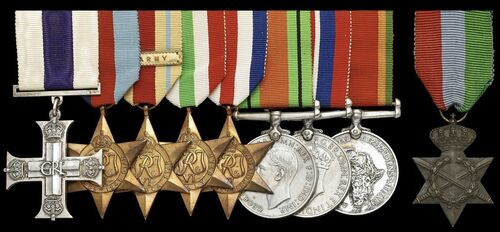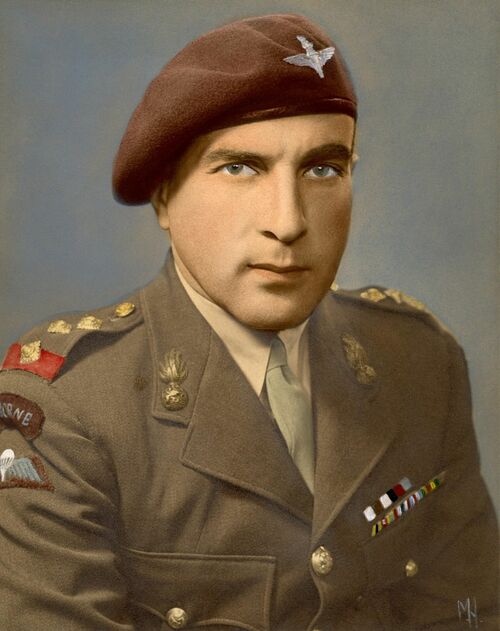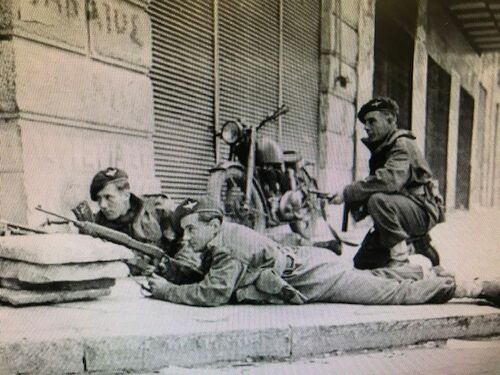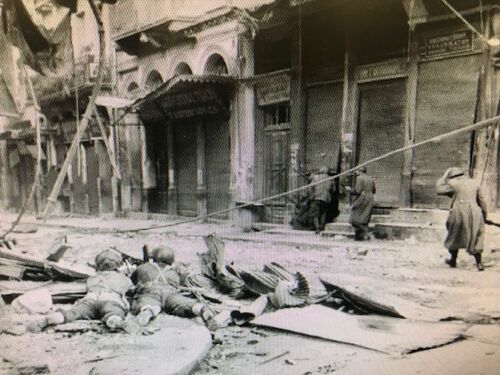Auction: 23003 - Orders, Decorations and Medals
Lot: 274
An outstanding Second World War M.C. group of nine awarded to Captain N. Vogelman, Parachute Regiment, later South African Engineer Corps, a gallant Jewish Officer who was severely wounded as a result of street fighting in Athens in January 1945 and one of the rare South African recipients of a France and Germany Star
Military Cross, G.VI.R., reverse officially dated '1945', reverse additionally engraved '30976. N. Vogelman'; 1939-1945 Star; Africa Star with 8th Army clasp; Italy Star; France and Germany Star; Defence and War Medal 1939-45; Africa Service Medal, the campaign medals all officially impressed '30976 N. Vogelman' as issued to South African troops; Greece, War Cross 1941, mountedas worn good very fine (9)
M.C. London Gazette 10 May 1945. Sold with a copy of a letter from Lieutenant-Colonel R. G. Bird O.B.E., based at the Ministry of Defence, London, dated 25 January 2001:
'Dear Mr Vogelman,
Thank you for your letter of 17 January requesting a copy of your MC citation. Regrettably an extensive search of our records including the London Gazettes of 1945-49 has failed to find any reference to this award. Whereas it would have been published correctly in theatre it was never actually confirmed in a London Gazette.
I have spoken to General Farrar-Hockley who believes that your citation along with orders from the 2nd Independent Parachute Brigade were probably lost in transit between the Middle East and London. This is obviously frustrating but I regret that there is nothing we can do about it now.
Although you do not have any written citation for your award you will always have the satisfaction of knowing that your selfless and courageous actions were recognised by a grateful Nation.
Yours sincerely, Richard Bird.'
Nathan Isaac Vogelman was born at Kimberley, South Africa on 6 July 1914, and was educated at Kimberley Boys' School. He was an Assistant Surveyor in the mining industry prior to the Second World War working for ERPM at Boksburg.
He attested at Bathsbury on 15 April 1940 and served with the 1st Battalion, Wit Rifles from 10 July 1940-19 November 1941. Vogelman thence served with the South African Engineer Corps from 19 November 1941-14 April 1944, firstly seeing service in Egypt from 17 October 1942-1 April 1943 and then serving in Tunisia and Egypt before going to the Italian theatre from 7 December 1943.
He was seconded to the British forces on 14 April 1944, whilst still serving in Italy and joined the 6th Battalion, Royal Welsh Fusiliers attached to the Parachute Regiment.
Vogelman continued to serve in Italy until 14 August 1944 before serving in France between 14 August 1944-1 September 1944. He returned to Italy serving from 3 September 1944 -15 October 1944, then served in Greece from 15 October 1944-14 January 1945, when he was shot through the chest and received four flesh wounds to his legs in the course of street fighting in Athens.
A Greek tragedy
By 1944, the two major resistance movements in occupied Greece, EDES and EAM-ELAS, each saw the other as the main adversary. They both recognized the fact that it was only a matter of time before the Germans evacuated the country. For the communists, the British represented their major opponent.
By the summer of 1944, the Soviet forces advancing into Romania and towards Yugoslavia meant that the Germans still in the Balkans were at risk of being cut off. In September, General Fyodor Tolbukhin's armies advanced into Bulgaria, forcing the resignation of the country's pro-Nazi government and the establishment of a pro-Communist regime, and the withdrawal of Bulgarian troops from Greek Macedonia. The Axis withdrawal, before the exiled government could return to the country, created a power vacuum. The government-in-exile, now led by the prominent liberal George Papandreou, moved to Italy, in preparation for its return to Greece. Under the Caserta Agreement of September 1944, all resistance forces in Greece were to be placed under the command of a British officer, General Ronald Scobie.
According to historian Donny Gluckstein, Scobie sought to delay the German withdrawal in order to prevent ELAS from establishing control of the country. He cites German plenipotentiary Hermann Neubacher for this claim.
The British arrived in Greece in October (Operation Manna) with the exiled Greek government and some units of the Greek army, led by General Thrasyvoulos Tsakalotos. By then, the Germans were in full retreat, and most of Greece's territory had already been liberated by Greek partisans.
On October 13, British troops entered Athens and Papandreou and his ministers followed six days later. King George II stayed in Cairo because Papandreou had promised that the future of the monarchy would be decided by referendum.
There was little to prevent ELAS from taking full control of the country. With the German withdrawal, ELAS units had taken control of the countryside and most of the cities. However, they did not take full control because the KKE leadership was instructed by the Soviet Union not to precipitate a crisis that could jeopardize Allied unity and put Stalin's larger postwar objectives at risk. Unlike their leaders, ELAS's fighters and rank-and-file were not aware of these instructions, and it became a source of conflict within both EAM and ELAS.
Following Stalin's instructions, the KKE leadership tried to avoid a confrontation with the Papandreou government. Most ELAS members saw the British as liberators despite some KKE leaders, such as Andreas Tzimas and Aris Velouchiotis. Tzimas was in touch with Yugoslav Communist leader Josip Broz Tito, and he disagreed with ELAS's cooperation with the British forces.
The issue of disarming the resistance organizations was a cause of friction between the Papandreou government and its EAM members. Advised by British ambassador Reginald Leeper, Papandreou demanded the disarmament of all armed forces apart from the Sacred Band and the III Mountain Brigade, which were formed following the suppression of the April 1944 Egypt mutiny, and two equal numbered corps of ELAS and EDES that would take part in operations against the Germans (still occupying Crete), such as the constitution of a National Guard under government control.
EAM, believing that it would leave the guerillas of ELAS defenseless against anticommunist militias, submitted an alternative plan of total and simultaneous disarmament. Papandreou rejected this plan, causing EAM's ministers to resign from the government on December 2.
On December 1, Scobie had issued a proclamation calling for the dissolution of ELAS. Command of ELAS was the KKE's greatest source of strength, and the KKE leader Siantos decided that the demand for ELAS's dissolution must be resisted.
Tito's influence may have played some role in ELAS's resistance to disarmament. Tito was outwardly loyal to Stalin but had come to power through his own means and believed that the Communists in Greece should do the same. His influence, however, had not prevented the EAM leadership from putting its forces under Scobie's command a couple of months earlier, in accordance with the Caserta Agreement. Meanwhile, following Georgios Grivas's instructions, Organization X members had set up outposts in central Athens and resisted EAM for several days until British troops arrived, as their leader had been promised.
According to the Caserta Agreement, all Greek forces were under the Allied command of Scobie. On December 1, 1944, the Greek government of "National Unity" under Georgios Papandreou and Gen. Scobie (British head of the Allied forces in Greece at that time) announced an ultimatum for the general disarmament of all guerrilla forces by 10 December, excluding those allied to the government (the 3rd Greek Mountain Brigade and the Sacred Band) and also a part of EDES and ELAS that would be used in Allied operations in Crete and the Dodecanese (still under German occupation), if it was necessary. As a result, on December 2, six ministers of the EAM, most of whom were KKE members, resigned from their positions in the "National Unity" government. The EAM called for a general strike and a demonstration in front of the Greek parliament for the next day, December 3.
The demonstration involved at least 200,000 people marching on Panepistimiou Street towards the Syntagma Square. British tanks along with Greek police units had been scattered around the area, blocking the way of the demonstrators.
The shootings began when the marchers had arrived at the Tomb of the Unknown Soldier, in front of the Royal palace, above Syntagma Square. They originated from the streets, from the building of the General Police Headquarters, from the Parliament (Vouli), from the Hotel Grande Bretagne (where international observers had settled), from other governmental buildings and from policemen on the street. Among many testimonies, N. Farmakis, then a fifteen-year old member of the Anti-EAM Organization X participating in the shootings, described that he saw the head of the police Angelos Evert giving the order to open fire on the crowd, by means of a handkerchief waved from the window. The sharpshooters had been given a standing order, according to Farmakis, "Don't fire as they are marching, at least up to the Tomb of the Unknown Soldier. When they march to the Tomb of the Unknown Soldier, open fire!" Although there are no accounts hinting that the crowd indeed possessed guns, the British commander Woodhouse insisted that it was uncertain whether the first shots were fired by the police or the demonstrators. LIFE photographer Dmitri Kessel, who witnessed the shooting, reported that the "police fired without provocation". More than 28 demonstrators were killed, and 148 were injured. This signalled the beginning of the Dekemvriana ("the December events"), a 37-day period of full-scale fighting in Athens between EAM fighters and smaller parts of ELAS, and the forces of the British army and the government.
At the beginning the government had only a few policemen and gendarmes, some militia units, the 3rd Greek Mountain Brigade—distinguished at the Gothic Line offensive in Italy, which, however, lacked heavy weapons — and the royalist group Organization X, also known as "Chítes", which was accused by EAM of collaborating with the Nazis. Consequently, the British intervened in support of the Greek government, deploying artillery and aircraft to reinforce their position as the battle approached its last stages.
In the early morning hours of December 4, ELAS reservists began operations in the Athens–Piraeus area, attacking Grivas' X forces and many police stations with success. In the evening, a peaceful demonstration and funeral procession took place by EAM members. Government forces took no action but the procession was attacked by Chites led by Colonel Grivas, with over 100 dead. Also on December 4, Papandreou gave his resignation to the British Commander, Gen. Scobie, who rejected it.
The government and British forces were confined only in the centre of Athens, in an area that was ironically called Scobia (Scobie's country) by the guerillas. The British, alarmed by the initial successes of EAM/ELAS and outnumbered, flew in the 4th Indian Infantry Division from Italy as emergency reinforcements. They also transferred John Hawkesworth from Italy to Athens, as assistant to Scobie, who soon took the general command.
Although the British were openly fighting against EAM in Athens, there were no such battles in the rest of the big cities. In certain cases, such as Volos, some RAF units even surrendered equipment to ELAS fighters. It seems that ELAS preferred to avoid an armed confrontation with the British forces initially and later tried to reduce the conflict as much as possible, although poor communication between its many independent units around the country might also have played a role. This might explain the simultaneous skirmishes with the British, the large-scale ELAS operations against trotskyists, anarchists and other political dissidents in Athens, and the many contradictory decisions of EAM leaders. Videlicet, KKE's leadership, was supporting a doctrine of "national unity" while eminent members, such as Leonidas Stringos, Theodoros Makridis and even Georgios Siantos, were creating revolutionary plans. Even more curiously, Tito was both the KKE's key sponsor and a key British ally, owing his physical and political survival in 1944 to British assistance.
This outbreak of fighting between Allied forces and an anti-German European resistance movement while the war in Europe was still being fought was a serious political problem for Churchill's coalition government in Britain and caused much protest in the British press and the House of Commons. To prove his peacemaking intentions to the public, Churchill went to Athens with General Alexander, Anthony Eden and Harold Macmillan at Christmas (December 25), to preside over a conference to bring about a settlement, in which Soviet representatives (Popov) also participated.
The conference was to take place in the Hotel Grande Bretagne. Later, it became known that there was a plan by the EAM to blow up the building, aiming to kill the participants, which was finally cancelled. Instead the conference took place in Phaliro, on the cruiser Ajax. From the Greek side Siantos, Partsalidis, Mantakas and Sofianopoulos took part for EAM and Regent Damaskinos, Papandreou, Panagiotis Kanellopoulos, Sofoulis, Kafantaris, Dimitris Maximos, Stefanos Stefanopoulos, Gonatas, Tsaldaris and as a special personality Nikolaos Plastiras for the government. It failed because the EAM/ELAS demands were considered excessive.
Meanwhile, the Soviet Union remained passive about developments in Greece. True to the informal Percentages agreement struck between Stalin and Churchill that placed Greece in the British sphere of influence, the Soviet delegation in Greece did not encourage or discourage the EAM's ambitions. The delegation's chief gained the nickname "sphinx" among local Communist officers for not giving any clues about Soviet intentions. Pravda did not mention the clashes at all.
By early January, EAM forces had lost the battle. Despite Churchill's intervention, Papandreou resigned and was replaced by General Nikolaos Plastiras. On 15 January 1945, Scobie agreed to a ceasefire in exchange for the ELAS's withdrawal from its positions at Patras and Thessaloniki and its demobilization in the Peloponnese.
The communist guerillas, led by Siantos, evacuated the capital taking thousands of hostages. During their retreat to central Greece, many of them died from the cold or hardships. ELAS took hostages to cover its retreat from RAF attacks. Circa 13,000 members of EAM/ELAS had also been arrested by the British and handed over to the Greek authorities.
The new government of Plastiras and the Communist party signed in February 1945 the Treaty of Varkiza in an effort of accord.
On 25 January 1945, a mass grave of some 200 people was found in Athens. Examiners estimated the bodies to be a month to 6 weeks old, which aligns with the period of the ELAS occupation of the area. None of the 200 were executed by gunshot, instead they were executed with hatchets, blunt instruments, or by stoning.
Vogelman himself was evacuated to Italy on 1 May 1945 where he remained until 27 June 1945. On 30 July 1945 his secondment ceases, being returned to the South African Engineer Corps and was finally discharged on 20 December 1945.
The severity of his wounds sustained in Greeece prevented him from going back in the mines, and he eventually went into the hotel industry in partnership with the Leo Nussbaum, eventually taking up ownership of the Brakpan Hotel and later owning the Three Fountains Hotel in Stilfontein.
Being Jewish, his quest to challenge injustice was not only reflected in his fight against fighting Fascism in Europe but also in South Africa. As a youngster he had pitched battles with the Ossewabrandwag, the neo-Fascist movement in South Africa. He had strong hostility for apartheid and in the 1980's he never wavered in the support for helping children who had been detained. Vogelman died in Johannesburg in 2007.
Sold together with a copy of the letter from the Hellenic Embasy Defence Attache, London, dated 16 May 2000 confirming the award and diploma for the Greek War medal, and a colour photocopy of the diploma.
Subject to 20% VAT on Buyer’s Premium. For more information please view Terms and Conditions for Buyers.
Sold for
£5,000
Starting price
£4500















